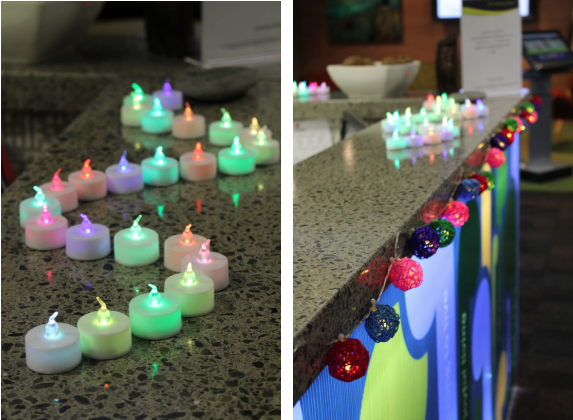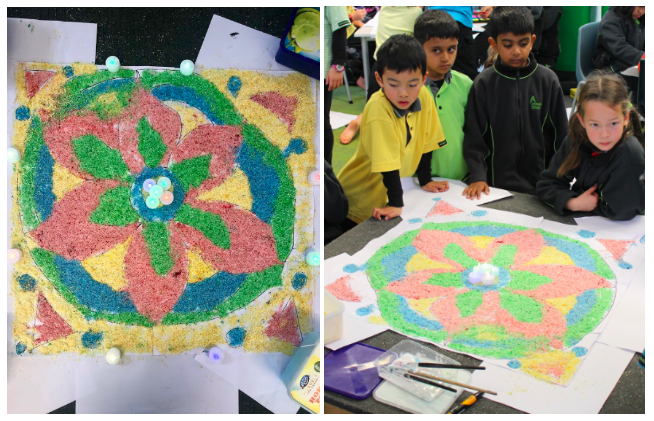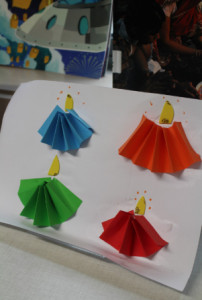What happened at Amesbury School during your week of festivities?
A group of teachers, students, and parents decorated our school with lights and lanterns to initiate Diwali celebrations. We displayed battery operated, coloured tea lights around our office area and hung strings of coloured lights through our learning hubs. The idea was to create a pathway of lights through our school like the pathway of lights in The Diwali Story that guide Rama and Sita home.
The lights immediately engaged our students and we could hear lots of excited chatter about them. Students were asking each other “Do you do this at your house? What does it mean? Why are the lights up?” Hearing the curiosity in children and the pride in sharing Diwali customs was a real highlight.
Student voice:
“The pathway of lights are nice and bright. It feels like you are in a place like India. In India it is really colourful. The warmth and the happiness of the religion flows through the school.”
We planned a range of learning opportunities for our students throughout the week of Diwali. Teachers in each learning hub ran different activities for their classes, which included:
- listening to and reading Diwali stories
- colouring rangoli patterns
- making a collaborative rangoli pattern using chalk and dyed coconut
- making barfi, a famous Indian sweet food
- researching Diwali customs
- making paper garlands.
We held a mufti day on the last day of Diwali (Friday 9 November) where we invited students to come to school in their own special occasion clothes. Many of our Indian students wore shalwar kameez or lehenga. Students from other cultures wore traditional clothing such as cheongsam or lederhosen and special occasion clothing such as shirts, dresses, blazers, and skirts. It was a true celebration of the multiculturalism of our school.
Some of our Indian students developed a slideshow presentation about the Diwali festival and shared it with the whole school during our Friday assembly. Their presentation embraced the principle of ako – they were our cultural experts bringing their knowledge, experiences, stories, and customs to the rest of the school.
We came together as a whole school on Friday afternoon to enjoy additional Diwali activities in our whānau groups.
Our focus on Diwali didn’t end on the last day of the festival. We are exploring the genre of report writing in our writing programmes and we have asked students to write news reports about our Diwali celebrations. We saw a perfect opportunity to capitalise on the learning and cultural experiences that we have all shared.
Cultural diversity
Teachers at Amesbury School brought the cultural diversity principle to life by celebrating Diwali as a community. Their week long programme reflected New Zealand’s cultural diversity and enabled students of Indian heritage to share their knowledge and customs.
Why celebrate Diwali at Amesbury School?
At Amesbury we have a culturally diverse student population with approximately 46% of our students identifying as Asian. Our largest two Asian ethnicities are Chinese and Indian. Key considerations are:
- How can we best support progress and achievement for our Asian students?
- How can we honour their cultural identities, languages, and cultures?
Two years ago we carried out a student wellbeing survey. The results from this survey showed that students believed their teachers knew them well as learners but not quite so well from a cultural perspective. In response to these findings we decided to work harder at reflecting the culture and traditions of all of our students in our school curriculum – allowing them to see their stories, values, and languages in the learning experiences that we offer, and allowing us to build greater understandings around their cultural identities. One of our strategic goals is to celebrate cultural events that are important to our students and their families.
Determining what cultural events we should celebrate has required community consultation. We surveyed our families to find out what festivals and events they honour. Their voices led us to add Diwali and the Lunar New Year to our school calendar. Matariki and te wiki o te reo Māori are other key events that we celebrate. We use the term Lunar New Year instead of Chinese New Year because our Korean families also celebrate this cultural event. We don’t want to isolate cultural groups in our school through our language.
We acknowledged Diwali last year but this is the first year that we have developed a comprehensive learning programme around it. We hope to make it an annual event that builds on the successes of previous years.
Student and community voice
The New Zealand Curriculum encourages schools to seek out and listen to the ideas of students, parents, whānau, and the wider community when designing their local curriculum. Amesbury School's decision to include Diwali as a key part of their curriculum was made in response to their student and community voice.
Where did you source your cultural expertise around Diwali?
Sonali, who is one of our junior school teachers, has Fijian Indian heritage and she celebrates Diwali every year with her family and friends. Sonali has led Diwali celebrations at our school this year. She shared her own experiences and knowledge of Diwali with the rest of the staff and sourced activity ideas from NZC Online. Our teachers have used Sonali’s cultural expertise and ideas to create engaging learning experiences for our students, recognising opportunities for curriculum integration.
Next year we hope to engage with our Indian parents and families more, inviting them to help shape our Diwali celebrations, share their customs and knowledge, and lead learning activities.
What is the impact of your Diwali celebrations?
The empowerment of our Indian students through our Diwali celebrations has been wonderful to see. They have delighted in having their culture, values, and stories acknowledged. These students have the experiences and they are putting their hands up to share their knowledge. This is supporting the development of their oral language, their self esteem, and their sense of cultural identity.
Celebrating Diwali shows our Indian students that we see them as individuals; that we respect their way of knowing. It also gives the rest of our students the opportunity to understand other cultural practices and to practice the values of manaakitanga (respect and care) and kaitiakitanga (guardianship and protection).
As students learned about the customs and beliefs around Diwali they began to recognise and discuss their own customs and beliefs. They compared Diwali traditions to their own traditions. This was an interesting outcome because earlier in the year some students found it difficult to see their own culture. Diwali helped students make the connections.
Providing sufficient opportunities to learn in the social sciences
Students from Amesbury School have had time and opportunity to develop conceptual understandings around identity, culture, and organisation. They explored the beliefs and customs of people from India through multiple activities and compared them to their own beliefs and customs and those of other New Zealanders.
Last year we repeated the student wellbeing survey and have noticed a significant shift in results. Many more students now feel that their teachers know and celebrate them as a culturally located person. We think that the integration of Diwali and other cultural events into our school calendar has influenced this shift.
What advice do you have for other schools who may want to do something similar?
- Start the planning early – get the event into your long-term plan and set aside time for the organisation.
- Look for cultural expertise in your school community. It could be a teacher, a parent, a grandparent, or a local Indian community group.
- Have some clear outcomes of what you want to achieve. You need to know your “why”.
- Integrate the event with other learning areas to create authentic learning opportunities.
- Harness the knowledge of your students, ask them to share the most important part of Diwali to them.
Amesbury School would like to thank the Asia New Zealand Foundation for their support. A grant from the Foundation was used by the school to purchase lights and other resources to support their Diwali and Lunar New Year celebrations.
You might like ...
Diwali – Festival of lights
This events page on NZC Online provides ideas and resources to help you celebrate Diwali with your students and school community.
- Tags:
- community engagement
- cultural diversity
- primary
- social sciences
- student voice
Return to top




